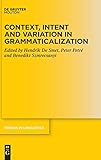Context, Intent and Variation in Grammaticalization / ed. by Hendrik De Smet, Peter Petré, Benedikt Szmrecsanyi.
Material type: TextSeries: Trends in Linguistics. Studies and Monographs [TiLSM] ; 365Publisher: Berlin ; Boston : De Gruyter Mouton, [2023]Copyright date: ©2023Description: 1 online resource (V, 307 p.)Content type:
TextSeries: Trends in Linguistics. Studies and Monographs [TiLSM] ; 365Publisher: Berlin ; Boston : De Gruyter Mouton, [2023]Copyright date: ©2023Description: 1 online resource (V, 307 p.)Content type: - 9783110752953
- 9783110753158
- 9783110753059
- 415
- online - DeGruyter
- Issued also in print.
| Item type | Current library | Call number | URL | Status | Notes | Barcode | |
|---|---|---|---|---|---|---|---|
 eBook
eBook
|
Biblioteca "Angelicum" Pont. Univ. S.Tommaso d'Aquino Nuvola online | online - DeGruyter (Browse shelf(Opens below)) | Online access | Not for loan (Accesso limitato) | Accesso per gli utenti autorizzati / Access for authorized users | (dgr)9783110753059 |
Browsing Biblioteca "Angelicum" Pont. Univ. S.Tommaso d'Aquino shelves, Shelving location: Nuvola online Close shelf browser (Hides shelf browser)

|

|

|

|

|

|

|
||
| online - DeGruyter Language Learning and Leisure : Informal Language Learning in the Digital Age / | online - DeGruyter Nietzsche's Political Economy / | online - DeGruyter Literary Spectacles of Sultanship : Historiography, the Chancery, and Social Practice in Late Medieval Egypt / | online - DeGruyter Context, Intent and Variation in Grammaticalization / | online - DeGruyter Translanguaging and the Bilingual Brain : A Mixed Methods Approach to Word-Formation and Language Processing / | online - DeGruyter Beschaffungscontrolling / | online - DeGruyter Digitalisierung und Zivilverfahren / |
Frontmatter -- Contents -- 1 General introduction -- 2 Looking at grammaticalization from the perspective of short-time changes in real time -- 3 A quantum of salience -- 4 Maximizing the data-drivenness of grammaticalization research -- 5 From chance to epistemic possibility -- 6 The structured nature of prepositional meaning -- 7 Competition in antagonistic verb complementation -- 8 Promoting and inhibiting forces at work -- 9 Making interpretation redundant -- 10 Straddling a syntactic divide -- 11 The development of prose style in English horse manuals -- Index
restricted access online access with authorization star
http://purl.org/coar/access_right/c_16ec
How is grammaticalization theory to accommodate the external factors that drive change and the competition that inevitably comes with change? This volume collects a wide range of papers at this intersection between grammaticalization theory and variationist linguistics. Grammaticalization and grammatical innovation, even if inevitably subject to formal change, are primarily driven by functional and communicative pressures. These include extravagant abuse of a construction for effect, but just as well reduction of its semantics to enhance its scope. Variation is shown to feed into this process through various means, including social embedding, functional competition (between variant constructions or between functions within a construction), stylistic specialization, contact-induced grammaticalization, but also analogical support of variant syntactic patterns. Attention is also paid to the methodological integration of variationist thinking and grammaticalization theory, including the issue of relative weight of language-internal and language-external variables, and how to measure their interaction. This study of grammaticalization through the lens of variation is of interest to all linguists studying language variation and change.
Issued also in print.
Mode of access: Internet via World Wide Web.
In English.
Description based on online resource; title from PDF title page (publisher's Web site, viewed 25. Jun 2024)


